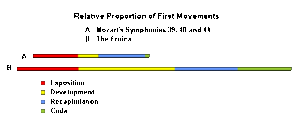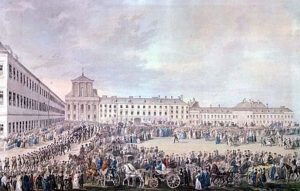Note: I have made references throughout this blog to timings for certain highlighted moments (e.g 0:06 of track 1) – this is in relation to a recording of the work I will link to below (follow along should you so desire)
Beethoven’s Eroica (heroic) Symphony – already the title tells us something, this is a work about heroism. Instrumental music had not really ever been about things in this way before this point. True, there had for a long time been programme music, but never before had a work become so embroiled in the world of ideas, politics and philosophy as this one became from its inception. The “Eroica” of course was not the original title. This was a symphony to be dedicated to a specific hero: Napoleon. It was to be Beethoven’s “Bonaparte Symphony”. Well that was until the former crowned himself emperor, and in response the composer angrily crossed out the dedication on the score. There were other heroes too in the composer’s mind when writing. Consider, for example, that the theme from the final movement is taken from his earlier music for the Ballet: ‘the Creatures of Prometheus’, and that this theme is in fact related to the opening heroic theme of the symphony. Could this then be a Promethean symphony, dedicated to the titan Prometheus who brought fire to mankind? The question to whom this symphony is really dedicated remains to a large extent unanswered, but is a question that I should wish to return to at the end. For now, though, I will focus on the heroic accomplishments of the music.
 Image from the manuscript of the Eroica, with Bonaparte angrily crossed out
Image from the manuscript of the Eroica, with Bonaparte angrily crossed out
The symphony begins with two great thundering chords of E-Flat major (0:06 of track 1), so familiar yet each time sounding so thrillingly new. An introductory staccato statement of chords such as this was not an uncommon device at that time, a kind of call to attention for the listener. In Haydn’s first quartet of his Opus 76 set, for example, he begins with three sharp chords, a kind of wake-up call to his aristocratic patrons that now was the time to stop chatting and start listening. But in this case, it feels different. It sounds more like a call to action. Then there begins a theme in the cellos (0:09 of track 1). It is a theme of utmost simplicity built to large extent from intervals of a third. It is in essence rather like a bugle call, but do not be deceived, this is the heroic theme upon which Beethoven will build an immense structure. The key is significant. From the first chords onward up till this point, we have been firmly in the symphony’s home key of E-Flat major. E-flat major was seen at the time as a noble key, a key associated with the enlightenment and works like Mozart’s Singspiel ‘Die Zauberfloete’. The choice was almost certainly deliberate.

Illustration of the opening heroic theme, taken from a website offering an analysis of the work
https://www.beethovenseroica.com/Pg3_anal/1mov/1m03.htm
We are not, however, allowed to dwell in this safe home territory for too long, the music moves down through D-natural to rest at C-sharp (0:13 of track 1). A false note, not within the E-flat major scale. In this short passage, then, already we see a microcosm of the whole movement, a movement which will evolve to become a titanic struggle. Although, we are reassuringly brought back to our home key by the strings and woodwind, the message is already clear: this symphony’s beauty will be built from conflict. It is not long before we encounter our second conflict, this time one rhythmical in nature (from around 0:30 to 0:42 of track 1). So far, the movement has kept unambiguously to its 3/4-time signature. This means there has been a natural accent on the first beat (123, 123, 123), but Beethoven now adds accents or sforzandi on alternating beats so that the meter becomes ambiguous (123, 123, 123, 123, and then, 123, 123). The listener will feel the violence in the music from these forceful sforzandi accents that intrude on the flow of the 3/4 meter.
From the start onward, then, the movement is full of struggle. It is also grand in size and scope. Beethoven expands the sonata-allegro form that Haydn and Mozart had utilised to suit his titanic designs, in particular, he enlarges the development section and coda greatly. The development section of the Eroica is extraordinary, it includes a passage of immense intensity in which dissonant chord is followed by even more dissonant chord (7:23 – 7:56 of track 1), and afterwards the composer shockingly introduces a new theme in E-minor (8:06 of track 1). The coda is developmental to a greater extent than ever before heard in a symphony, but also crucially to the drama of the whole work, it refrains from bringing the tension to a final close. That will have to wait until the very last movement (13:05 to the end of track 1).

First movement proportions in comparison to works by Mozart (taken from the same website), Mozart’s last three symphonies = A, Eroica = B
Red: exposition, yellow: development, blue: recapitulation, green: coda
The Second movement is a funeral march, something never before included in a symphony (though there is a funeral march in Beethoven’s piano sonata No. 12 published in 1801). By using a funeral march Beethoven was making a reference to the public ceremonial music of the French Revolution, and thereby associating the work with the radical politics of his day. Significantly, this movement can be used to refute any simplistic interpretation of the work as a programmatic piece about Napoleon, since the French general was still very much alive and on the scene at the time. The limited space I have here compels me to focus on one particular moment of this movement and that is the fugue around the mid-point of the movement (from 5:51 of track 2). This is a moment of such sublime, impassioned beauty that it simply demands to be highlighted. With the third movement the audience is to some extent offered a respite from the intensity of the music, though the musicians are certainly not let off from the challenges of the score. I am thinking particularly of the trio section (the middle part of this movement), in which the first horn must play music towards the high end of its register while the two lower horns must execute a difficult passage towards their lower end (2:35 – 3:57 of track 3).

Painting of the procession at Beethoven’s own funeral in Vienna (1827)
As I briefly mentioned above, the main melody from the last movement is found in the composer’s earlier Ballet music for ‘the Creatures of Prometheus’. This meant that Beethoven probably envisaged this final movement first, though the work of musicologists has shown he composed it last. We do not begin, however, with the tune, but instead after an initial burst from the strings (0:00 of track 4), the orchestra outlines the bass line of this theme (0:12 of track 4). This is a theme and variations movement, in which the melody of the theme is heard for the first time only in the third variation (1:51 of track 4). The theme metamorphoses before our eyes through a variety of guises, at times light-hearted, at times serious and grand, and Beethoven demonstrates profoundly his contrapuntal mastery at several points. Towards the end, we have what is for me a truly glorious moment in which the horns take up an augmented version of the melody (7:47 of track 4). A fog of doubt prepares us brilliantly for the final orchestral eruption leading to a triumphant finish for the movement and the symphony.

An image from a staging of the Ballet “The Creatures of Prometheus”
But a triumph for whom? We are, again, confronted with the same question all these years later, who is the hero to which this heroic symphony is ultimately dedicated. Is it Napoleon, dubbed the World-Spirit on horseback by Hegel, who ultimately disappointed so many liberals in Europe including Beethoven? Or is it Prometheus, the mythical Titan and benefactor to mankind, who appeared to be the archetypal hero for the enlightenment. I myself am more attracted by other interpretations. Wagner suggested it was the artist and Beethoven in particular who was the hero. This man who lost that sense most dear to him: his hearing, but who nonetheless struggled through it all anyway, despite the immense pains of illness, the personal strife, the unending setbacks. Without a doubt Beethoven seems to be a very suitable choice. But I would go a step further and caste us all in the role of hero. In the end, every life involves struggle, all life includes sacrifice, those that can take it upon themselves to face the challenges of the world and who choose to live and to live life to its fullest extent can consider themselves heroes.
Here is the recording upon which the timings are based, you are more than welcome to choose your own performance but please note the timings could be very different if you do:

